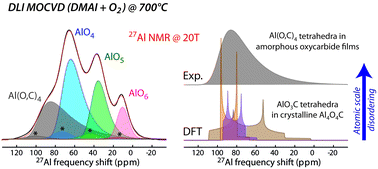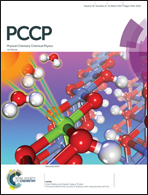Atomic scale structure of amorphous aluminum oxyhydroxide, oxide and oxycarbide films probed by very high field 27Al nuclear magnetic resonance†
Abstract
The atomic scale structure of aluminum in amorphous alumina films processed by direct liquid injection chemical vapor deposition from aluminum tri-isopropoxide (ATI) and dimethyl isopropoxide (DMAI) is investigated by solid-state 27Al nuclear magnetic resonance (SSNMR) using a very high magnetic field of 20.0 T. This study is performed as a function of the deposition temperature in the range 300–560 °C, 150–450 °C, and 500–700 °C, for the films processed from ATI, DMAI (+H2O), and DMAI (+O2), respectively. While the majority of the films are composed of stoichiometric aluminum oxide, other samples are partially or fully hydroxylated at low temperature, or contain carbidic carbon when processed from DMAI above 500 °C. The quantitative analysis of the SSNMR experiments reveals that the local structure of these films is built from AlO4, AlO5, AlO6 and Al(O,C)4 units with minor proportions of the 6-fold aluminum coordination and significant amounts of oxycarbides in the films processed from DMAI (+O2). The aluminum coordination distribution as well as the chemical shift distribution indicate that the films processed from DMAI present a higher degree of structural disorder compared to the films processed from ATI. Hydroxylation leads to an increase of the 6-fold coordination resulting from the trend of OH groups to integrate into AlO6 units. The evidence of an additional environment in films processed from DMAI (+O2) by 27Al SSNMR and first-principle NMR calculations on Al4C3 and Al4O4C crystal structures supports that carbon is located in Al(O,C)4 units. The concentration of this coordination environment strongly increases with increasing process temperature from 600 to 700 °C favoring a highly disordered structure and preventing from crystallizing into γ-alumina. The obtained results are a valuable guide to the selection of process conditions for the CVD of amorphous alumina films with regard to targeted applications.



 Please wait while we load your content...
Please wait while we load your content...